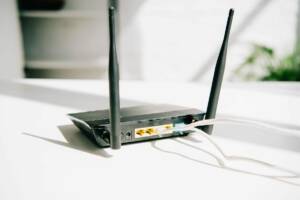A single Wi-Fi router may not cover the entire coverage area of your home or office. In this case, setting up your router as a Wi-Fi repeater is a great way to extend your coverage area. A Wi-Fi repeater works as a signal booster that takes the signal from your main router and repeats it, increasing the coverage area for your device. Setting up your router as a Wi-Fi repeater can help you save money by not having to buy an additional Wi-Fi router. What’s more, a Wi-Fi repeater can work with any Wi-Fi router, making it a versatile solution for extending your coverage area. If you have an old Wi-Fi router that you no longer use, you can use it as a Wi-Fi repeater. Setting it up is super easy with our detailed guide that will help you set up your router as a Wi-Fi repeater in a few minutes. Additionally, setting up your router as a Wi-Fi repeater can improve the speed and quality of the Wi-Fi signal in your coverage area. This is especially important for those who live in larger homes or offices where the Wi-Fi signal may be weak in some areas. Overall, setting up a router as a Wi-Fi repeater is a great way to extend your Wi-Fi coverage while saving money and improving signal quality. Follow our detailed guide to set up your router as a Wi-Fi repeater in minutes. If your home or office has areas with poor Wi-Fi reception, using your router as a repeater can be a great solution. A router as a repeater increases Wi-Fi coverage by repeating the signal from your main router. This means you can enjoy more stable and high-quality Wi-Fi anywhere in your home or office. The benefits of using a router as a repeater include ease of setup, the ability to use your existing router, and reduced hardware costs. Follow our detailed guide to set up a router as a Wi-Fi repeater and enjoy improved Wi-Fi coverage in your home or office.
When does it make sense to use a router as a Wi-Fi repeater?
Sometimes it happens that the Wi-Fi signal does not cover the entire territory of the house or apartment. In such cases, many users choose to solve the problem by installing a Wi-Fi repeater. But what if there is no Wi-Fi repeater? In such cases, you can use a regular router as a Wi-Fi repeater.
If you have an old router that is no longer in use, you can use it as a Wi-Fi repeater. This will increase the Wi-Fi coverage area in your home or apartment. It's important to note that routers manufactured before 2010 may have limited capabilities as a Wi-Fi repeater.
Using a router as a Wi-Fi repeater has several advantages. Firstly, this is a cheaper solution than buying a special Wi-Fi repeater. Secondly, installing a router as a Wi-Fi repeater does not require much knowledge in the field of network technology.
In the next part of the article we will tell you how to configure your router as a Wi-Fi repeater.
How to choose a suitable router to use as a Wi-Fi repeater? This is an important question because not all routers are suitable for this task.
First, you need to make sure that your router supports the Wi-Fi repeater function. This information can be found in the device instructions or on the manufacturer's website.
Secondly, pay attention to the speed and frequency range of the router. The higher the speed and frequency, the better your repeater will perform.
It is also worth paying attention to the number of antennas on the router. The more antennas, the stronger the signal and, accordingly, the better the repeater will work.
Lastly, make sure your router is compatible with the devices you'll be connecting to Wi-Fi. If you have devices that support older versions of Wi-Fi, then you need to choose a router that supports them.
So, when choosing a router to use as a Wi-Fi repeater, make sure that it supports this function, has high speed and frequency, a sufficient number of antennas, and is compatible with your devices.
In this article, we will look at a detailed guide on setting up a router as a Wi-Fi repeater. This can be useful if you have a large home or office and the Wi-Fi signal does not cover all rooms.
Step 1: Connect your router to your computer using an Ethernet cable.
Step 2: Launch your browser and enter your router's IP address in the address bar. Usually it's 192.
168.
1.
1 or 192.
168.
0.
1.
Step 3: Enter your username and password to log into the router interface. If you do not know this information, check your router documentation or contact your Internet service provider.
Step 4: Find the 'Wireless' or 'Wireless Network' section and select 'Repeater' or 'Repeater'.
Step 5: Enter the name and password to connect to the main Wi-Fi network you want to expand.
Step 6: Select a Wi-Fi channel for the repeater. Commonly used channels are 1, 6, and 11.
Step 7: Save the settings and reboot the router.
Step 8: Connect your devices to the Wi-Fi repeater and enjoy the extended signal range.
We hope this guide will help you set up your router as a Wi-Fi repeater and improve the signal quality in your home or office.
Preparing for setup
Before you start setting up your router as a Wi-Fi repeater, you need to make sure that the device supports this operating mode. To do this, you can refer to the documentation for the router or search for information on the Internet.
You also need to know the login and password for the router, as well as the access address to its settings. Usually it's 192.
168.
0.
1 or 192.
168.
1.
1, but maybe another.
Next, you should prepare the Wi-Fi repeater. It must be set to repeater mode and have access to the Wi-Fi network that needs to be expanded. If the repeater is new, then you need to configure it in accordance with the instructions.
You should also make sure that the repeater is within range of the Wi-Fi network that you want to expand. It is best to place it where the signal from the main router is still strong enough.
After preparing the router and repeater, you can start setting them up. Follow the instructions that will be presented in the following sections of the article. To set up a router as a Wi-Fi repeater, you need to follow a few simple steps. Step 1 - connect the router to the computer. To do this, you need to use an Ethernet cable that connects to one of the LAN ports of the router and to the network card of the computer. After connecting, you need to turn on the router and the computer.
Then you need to open your browser and enter the router's IP address in the address bar. Usually the IP address is indicated on the device itself or in its instructions. After entering the IP address, you must enter a login and password to access the router settings.
After successfully entering the router settings, you need to go to the “Wireless” or “Wi-Fi” section. There you need to select the “Repeater” or “Range Extender” option and enter the SSID (network name) and password for the existing Wi-Fi network.
After this, you need to save the settings and reboot the router. The router is now configured as a repeater and should repeat the Wi-Fi signal of the existing network, expanding its coverage area. After connecting to the router via Wi-Fi or LAN cable, you need to enter the router settings. To do this, you need to enter the IP address of your router in the address bar of your browser. Usually it's 192.
168.
0.
1 or 192.
168.
1.
1. If you have forgotten the IP address of your router, you can find it in the documentation that came with the device, or search for it on the Internet.
After entering the IP address in the address bar of the browser, the authorization page will open. Typically, the login and password for entering the router settings are indicated in the documentation or on the device itself. If you don’t know your login and password, you can try standard combinations: admin/admin, admin/1234, user/user, etc.
d. If the standard login and password do not suit, then you can reset the router settings to factory settings.
After successful authorization, you need to find the Wi-Fi section in the router settings and select the router operating mode as a repeater. In this mode, the device will extend the Wi-Fi signal of the main router rather than create its own network.
Next, you need to enter the SSID (network name) and password of the main router that will be used by the repeater. You can also select a Wi-Fi channel and configure other settings.
After saving the settings, the router will reboot and start working in repeater mode. Now you can connect to an expanded Wi-Fi network and enjoy an improved signal.
Step 3: Setting up the router as a Wi-Fi repeater
To configure your router as a Wi-Fi repeater, you must complete the following steps:
1. Connect your computer to the router via an Ethernet cable.
2. Go to the router settings by entering the router's IP address into the address bar of the browser.
3. In the router settings menu, find the “Wireless” or “Wireless Connection” section.
4. In this section, find the “Repeater” or “Repeater” option and turn it on.
5. Enter the SSID and password of the main Wi-Fi network you want to extend with the repeater.
6. Click the "Save" or "Save" button.
7. Connect the repeater to the main router using an Ethernet cable.
8. Check that the repeater is connected to the main Wi-Fi network and is working as a repeater.
Your router is now configured as a Wi-Fi repeater and can extend the coverage of your main Wi-Fi network.
Step 4: Checking the functionality of the Wi-Fi repeater router
After setting up the router as a Wi-Fi repeater has been completed, you need to make sure it is working. To do this, you can use any Wi-Fi-enabled device, such as a smartphone or laptop.
First you need to connect to your main Wi-Fi router, check your Internet speed and make sure everything is working correctly. Then you need to go to another room where the repeater router is located and try to connect to it. If the device successfully connects to the repeater and the Internet works at a stable speed, then the setup is correct.
You can also check the repeater's operation by moving around your home and observing the quality of the Wi-Fi signal. If the signal drops or disappears in certain areas of the house, then it is necessary to move the repeater closer to these areas.
In general, checking the functionality of a Wi-Fi repeater router takes no more than 10-15 minutes, but it allows you to make sure that the setup is done correctly and Wi-Fi is working without failures.
Additional tips for optimal performance of your Wi-Fi repeater router
Setting up your router as a Wi-Fi repeater is a great way to increase Wi-Fi signal coverage in your home or office. However, to get the best performance from your repeater router, there are a few important things to consider.
1. Select the correct location for the repeater. The repeater router should be within the coverage area of the main router, but should not be too far from devices that will use the Wi-Fi signal.
2. Set up Wi-Fi channels. If there are many Wi-Fi networks in your area, congestion may occur on one channel, resulting in poor performance. To avoid this, set the Wi-Fi channels on your main router and repeater to different values.
3. Install the latest firmware update. Updating the firmware can resolve performance issues and improve the overall performance of the repeater.
4. Limit the number of devices connected to the repeater. The more devices connected to the repeater, the lower the speed and stability of the Wi-Fi signal. Limit the number of devices and see how this affects performance.
By following these simple tips, you can set up your router as a Wi-Fi repeater and get the best performance from your Wi-Fi network.
conclusions
As a Wi-Fi repeater, you can use not only special devices, but also a regular router. To do this, you need to configure it accordingly. In this article, we looked at a detailed guide to setting up a router as a Wi-Fi repeater.
The main thing to remember is the correct connection to the main network so that the router can repeat the signal. You will also need to configure your new Wi-Fi settings to be different from your main network.
When setting up a router as a Wi-Fi repeater, you must take into account that the connection speed will decrease since the signal will pass through two routers. However, it is a great solution for increasing Wi-Fi coverage in your home or workplace.
By following our instructions, you can set up your router as a Wi-Fi repeater without any problems. We hope that this article was useful to you and helped you understand this topic.
Read further:






